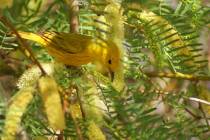Here’s the poop on fighting pigeon problems
They're feathered, but they're not your friends. Pigeon droppings contain acids that can eat through the tiles on your roof. Also present are salmonella and the fungus that causes histoplasmosis, according to the Southern Nevada Health District.
"Fecal matter from any animal in significant quantities is certainly unhealthy," says Vivek Raman, the district's environmental health supervisor.
The R-J consulted three pigeon-control experts -- Pigeons Be Gone owner Mike Gardner, Summerlin Pest Control owner T.J. Broniecki and Nevada Pigeon Control director of field operations Nephi Oliva -- on what to do about these pesky birds. Most agreed on the following steps homeowners can take before calling a professional.
REMOVE ALL DROPPINGS AND NESTING MATERIALS
The scent of their own toilet will keep pigeons, and their buddies, coming back.
Before removal, wet droppings down with a disinfectant mix of one part bleach to nine parts water, either in a spray bottle or garden sprayer. Also, wear gloves and a respirator or very fine mask. If the material is caked on, a trowel may be required. Hose down the area afterward.
DON'T FEED THEM
Pigeons don't need us to sit on a park bench with a bag of sunflower seeds. We're also feeding them when we don't seal the lids on our trash cans, and when we feed our dogs, cats or "cuter" birds in our backyards. (Pets make crumbs when they eat, and the ground beneath even "pigeon-proof" feeders makes for great foraging.)
On a related note, always use a protective cover after seeding your lawn.
DON'T HYDRATE THEM
Avoid watering during the day, when pigeons are awake. And bury all drip systems. Even the heavily chlorinated water in fountains, pools and spas will supply life-sustaining hydration -- although it may sting Tweety's eyes. For your pool and spa, keep at least six inches between the edge and the waterline to curtail dunking.
CHASE THEM OFF
Oliva recommends the "ball and key" method: shake your keys and hurl a tennis ball. Birds will learn to associate your property with a high sense of alarm. Squirts from your hose will work for birds on the roof.
"On the third day, you'll think it's not working," Oliva says. "On the fourth day, they won't show up."
If the pigeons are already nesting, however, forget it.
SCREEN OFF EAVES
If climbing 20 feet up a ladder scares you less than a pest-control bill, find your eaves (the spaces between roofs that provide shelter from the sun, wind and rain).
Oliva does not believe in screens. However, the other two experts say they're so effective, they should be erected even before pigeon problems develop.
Wire is available at any hardware store. But it needs to be heavy -- at least 14 gauge, according to Gardner, because pigeons will push through thinner chicken wire.
Attaching it also is tricky. Screws need to go into the wood fascia, not the tiles. Otherwise, you can cause a leak in your roof and void your builder's warranty.
SPIKES
They're available for about $15 per short row at most larger nurseries and hardware stores. But they don't work well. Pigeons can simply stand a few inches to the left or right. Adding insult to injury, some even use them to build nests.
MOTION-SENSOR SPRINKLER
These work, but pigeons can learn to avoid the area in which the water sprays. Installing them -- including their feed hoses -- all over one's property and roof would be ridiculously unsightly and costly. (They're $54.99 a pop at Star Nursery.)
TRAPS
These work, too, but bait seed will attract more birds to your property than the trap will capture.
In addition, you can't just take your "jailbirds" somewhere and let them go, because they'll fly right back to your/their home. (All pigeons are innately homing.)
If this is the way you want to go, Oliva recommends livetrap.com, where pigeon traps start at $82.88 plus shipping. Provided that you feed and water them, Oliva says that you can bring captured pigeons to his sanctuary at Nevada Pigeon Control, 3930 Crooked Oak St. in North Las Vegas. Gilcrease Nature Sanctuary, 8103 Racel St., also will accept them.
Contact reporter Corey Levitan at clevitan@reviewjournal.com or 702-383-0456.
BIRDBRAINED IDEAS
Here are some pigeon-removing strategies best avoided.
Fake owls: These must be a funny joke in the pigeon world. T.J. Broniecki of Summerlin Pest Control reports that birds often roost atop them. Even the ones that emit a motion-triggered hoot work only for a few days, according to Nevada Pigeon Control's Nephi Oliva, for the same reason that pigeons often nest under air conditioners: Eventually, they learn that the intermittent noise is harmless.
Repellent: Polybutene gels work by making the roof sticky, which pigeons don't like. The adhesive lasts about six months to a year.
Meantime, dust, dirt, droppings, feathers and dander are collected, making removal a maintenance nightmare.
Poison: Avitrol is the most effective, but none of the experts consulted by the R-J either uses or recommends it. It could poison other birds and animals -- directly or by ingestion of the poisoned pigeons. And even the best-case scenario leaves you with carcasses that, if not all cleaned up, will lead to worse health problems. You'll also be breaking the law, since obtaining, possessing or using Avitrol requires professional certification in all 50 states.





























